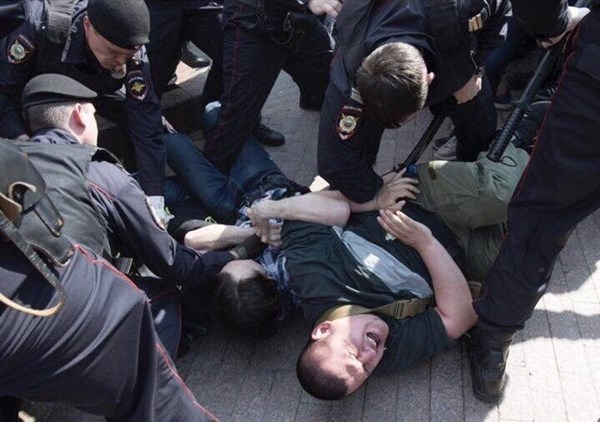Massive protests against Putin's inauguration held in Russia
On Saturday, May 5, supporters of Alexei Navalny held rallies in dozens of Russian cities under the slogan "He is not our tsar.” They were timed to the inauguration of Russian President Vladimir Putin, which will be held on May 7. The protest in Moscow was not authorized by the authorities.
The protest rally was scheduled for two o'clock in the afternoon at Pushkin Square. Several hundred people had already gathered in the square an hour before. Many of them wore St. George ribbons and flags, while some wore forage caps.
Among them were members of the National Liberation Movement. They handed out the ribbons and copies of their association newspaper featuring a photo of Vladimir Putin on the first page. They shouted "The Maidan will not pass!" and sang songs about the war years to accordion music.
At that time, the Navalny supporters were unfolding individual posters against corruption and for free Internet. Members of the National Liberation Movement approached them, asked why they did not like Putin and who paid them for the protest. Those conversations were recorded on mobile phone cameras.
The Cossacks arrived at the protest. They stood at a distance from the Pushkin monument, in the park and talked to the opposition. They argued with a woman about who was stronger: Putin or Navalny. "I do not know if Navalny is strong, but the whole power of Putin is in his corrupt friends." "Prove it," the Cossacks urged. "Read on the Internet. Therefore, no lousy sheep will come to him for the inauguration," the woman said, concluding the discussion.
At the same time, two women were so fiercely debating about who has the right to be on the square, that they started to fight. They were quickly separated by others.
It was easy to distinguish the supporters of Navalny from the members of the National Liberation Movement. The opposition protesters stood mostly alone, holding white flowers or homemade posters. Like the January rally, there were many youths and schoolchildren among them. Some youths covered their faces with masks.
"This man was guarding the flowers on the bridge at the site of Nemtsov's murder," 13-year-old Kirill explained to a DW correspondent. "That guy was at a rally in support of Telegram." When asked how he knows everyone, he said that he has been participating in the rallies for a year. "These are fine people," said Kirill and fled into the crowd.
During the Navalny’s unauthorized January rally on Pushkin Square, the OMON, special police units of Federal Police within the National Guard of Russia largely refrained from detaining the participants, even when a crowd of shouting teenagers went to the Kremlin.
This time, law enforcement officers did not hide their intentions. "The protest is not approved. Physical force and special means against you will be used," a megaphone near the square was announcing repeatedly.
Soon after the rally began, police vans drove up to the square. OMON policemen, pushing people aside, formed living corridors. In groups of six, they passed through the corridors, entered the crowd and started taking the protesters. Most were dragged away and those who resisted were beaten fiercely with truncheons.
The crowd shouted "Shame!" and "The police—with the people." Protesters launched paper airplanes at the police, a symbol of the Telegram support rally. Some linked arms and tried to block the riot policemen. They were also detained.
On the other side of the square, men in Cossack uniforms collided with opposition protesters and began to beat them with whips. The police did not stop them and did not detain them.
More police vans quickly arrived to replace those that were full. After another arrest, the supporters of Navalny ran out onto the roadway of Strastnoy Boulevard and blocked traffic. People applauded and shouted slogans. A police van tried to disperse the crowd on the road. Young people stood their ground in front of it. A column of riot police pushed them to the sidewalk.
Driven away from the Pushkin Square, the protesters chaotically continued the movement. Some went to Triumfalnaya Square, others, mostly young people, went through Bolshaya Dmitrovka St. towards the Kremlin. They were shouting: "The authorities should be replaced," "Durov is our hero," and "We want the same as in Armenia."
Having reached Manezhnaya Square, the protesters again faced riot police who held clubs and shock batons. People, dodging, ran towards Lubyanka. The detentions continued in front of the Metropol Hotel. Together with journalists, a large group of Japanese tourists watched them. They asked what was going on and were filming the events.
At six in the evening, those who were not detained returned to Pushkin Square again. Cossacks and National Liberation Movement members were no longer there. The protesters were sitting on benches or standing silently. In half an hour the area was cordoned off and dozens of riot policemen literally pushed people to the entrances to the metro. This was the end of the protest.
According to OVD-Info, 704 people were detained in Moscow, some of whom have already been released. Overall, more than 1,600 people were detained on that day.
